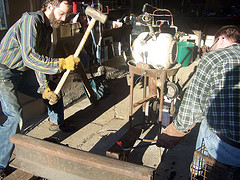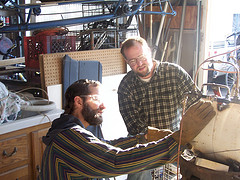Annealing and Metallurgy - The Different Stages and Processe
 The process is commonly seen to involve steps like heating above temperature then normalizing it. After which, cooling of the material will be necessary. It softens a material or induces ductility while shaping, forming or stamping it to the desired output.
The process is commonly seen to involve steps like heating above temperature then normalizing it. After which, cooling of the material will be necessary. It softens a material or induces ductility while shaping, forming or stamping it to the desired output.
Three stages are linked to the annealing process, namely:
Recovery phase. This is that point when the metal is softened by means of removing defects on the crystals and whatever internal stress the dislocation causes. This stage covers the instance before any stains or grains are seen on the material.
Recrystallization phase. This is the phase when new grains grow on the material. This is said to replace those that were deformed and removed during the recovery phase.
Grain growth phase. This stage results to a problem on the material. Since grains occur, there is a tendency for the output to coarsen thus making the metal less satisfactory than usual.
Annealing process
The annealing process is known by other names. It may often be referred to as intermediate, subcritical or in–process annealing. This is the cycle for heat treatment allowing the material to be more ductile or flexible without having the tendencies of breaking while it is worked at. The processes will involve rolling, drawing, spinning, forging or extruding. The material is heated first then will be set to cool down.
Several other processes may complete annealing. A full or a short cycle may be opted depending on the material being worked on. Materials such as silver, copper, brass and other alloys are also used in the process. The process is considered special because it does not have any complications with decarburization.





Understanding Ferrous Metallurgy and Sheet Metal
 Ferrous metallurgy at first seems like a fancy, and perhaps antiquated, art form. But it is just a technical way of saying ironwork. Ferrous is a word derived from the Latin word ferrum, and simply refers to substances containing or consisting of iron. Ferrous metals include steel and pig iron (with a carbon content of a few percent) and alloys of iron with other metals (such as stainless steel). The term non–ferrous is used to indicate metals other than iron and alloys that do not contain an appreciable amount of iron. Metallurgy is the branch of science and technology concerned with the properties of metals and their production and purification.
Ferrous metallurgy at first seems like a fancy, and perhaps antiquated, art form. But it is just a technical way of saying ironwork. Ferrous is a word derived from the Latin word ferrum, and simply refers to substances containing or consisting of iron. Ferrous metals include steel and pig iron (with a carbon content of a few percent) and alloys of iron with other metals (such as stainless steel). The term non–ferrous is used to indicate metals other than iron and alloys that do not contain an appreciable amount of iron. Metallurgy is the branch of science and technology concerned with the properties of metals and their production and purification.
The History of Ferrous Metallurgy:
Working with iron has a rich and detailed global story. Metalworking began well before humans began recording history. The use of iron was known during the first millennium. The earliest metal objects were found in China from the second millennium and were made of iron and nickel. Steel was first produced in antiquity. During the industrial revolution, new methods of producing bar iron without charcoal were devised and these were later applied to product steel.
In the late 1850s a new steel making process was implemented which involved blowing air through pig iron. Iron smelting – the extraction of usable metal from oxidized iron ores – is more difficult than other elements, like nickel. Smelted iron requires hot working and can be melted only in specially designed furnaces.
Until the 19th century, steel was an expensive commodity and only used when a particularly hard or flexible metal was needed. The widespread availability of inexpensive steel powered the Second Industrial Revolution and allowed for the development of modern cities. Mild steel ultimately replaced wrought iron for almost all purposes, and stainless steel was developed on before World War I and was not widely used until the 1920s.
Today, steel is one of the most common materials in the world, with more than 1300 million tons produced annually. It is a major component in buildings, infrastructure, tools, ships, automobiles, machines, appliances, and weapons.
The Evolution of Steel and Modern Metalworking:
Iron gave way to steel and steel gave way to modernity. Stainless steel, as well as aluminum, has been used in the form of sheet metal, which is metal formed into thin and flat pieces. Now, companies have facilities that create custom components for a broad spectrum of industries: agriculture, communications, electronics, material handling, medical, lighting, machinery, printing, and others. They employ many sheet metal fabrication techniques, such as laser cutting, shearing, punching, press brake forming, and wielding assembly, among others.
The manufacture and distribution of iron and sheet metal are as varied as their application. They have been used in nearly every industry, from food production to housing, and continue to have a dramatic impact on mankind throughout the world.





The Four Different Types of Metals and Their Contribution to
 The earth is indeed an amazing and perfect place to live. It has the things that are necessary for us to survive. It provides with the enough resources for our needs. There is no place like earth. Humans are the highest level of organism living on this planet. We are even termed as the stewards of this place. Although plants and animals are also considered as living organisms, humans are given the chance and the will to utilize the natural resources that can be found on earth.
The earth is indeed an amazing and perfect place to live. It has the things that are necessary for us to survive. It provides with the enough resources for our needs. There is no place like earth. Humans are the highest level of organism living on this planet. We are even termed as the stewards of this place. Although plants and animals are also considered as living organisms, humans are given the chance and the will to utilize the natural resources that can be found on earth.
These natural resources include plants, wood and minerals. Metal is one of the oldest minerals on this planet. It has been used in different reasons. During the early civilizations metal has been used as a weapon. It is very much known for its hardness and durability.
Most of the people nowadays are confused about the properties and functions of metal. Metal is not just actually iron. There are different types of metals that can be found on the surface of the earth and even on its inner core. The different types of metals have their own characteristics and properties.
The most expensive type of metal is gold. Gold has been one of the finest materials used in making jewelries. Gold has become the sign of wealth for most of the people. It could be found on the crust of the earth. The process of extracting gold from ordinary rocks is very difficult. It would take time before you can have it as jewelry. During the early periods the main significance of gold is for decoration. Gold is also very popular to be the most malleable of all the metals.
Next to the value of gold is silver. Silver has been also used as a form of jewelry. It can be made into anklets, bracelets, earrings, necklaces and rings. However unlike gold, silver has a lower value in terms of money. The presence of silver rarely occurs, however it is the most active of all the metals. You will know more about the properties of metals using a periodic table.
The third and unusual type of metal is mercury. It is the only metal that can be found on the earth which is purely liquid at a room temperature. Mercury has been noted to be the most dangerous type of all metals. The main process used to extract mercury is through distillation. It is also used during the extraction of gold because of its capacity to attract gold.
The last type of metal is iron. Iron became synonymous of metal for some individuals. It is because they thought that the main property of characteristics of metal is its hardness. Iron is the most useful and valuable type of metal. It is often used to create nails, construction equipments and railings. Iron is very versatile in terms of making things out of it because of its malleability. The history of metallurgy can be fully traced using the periodic table of elements. It will provide you the basic knowledge about how metals became useful to humans.




